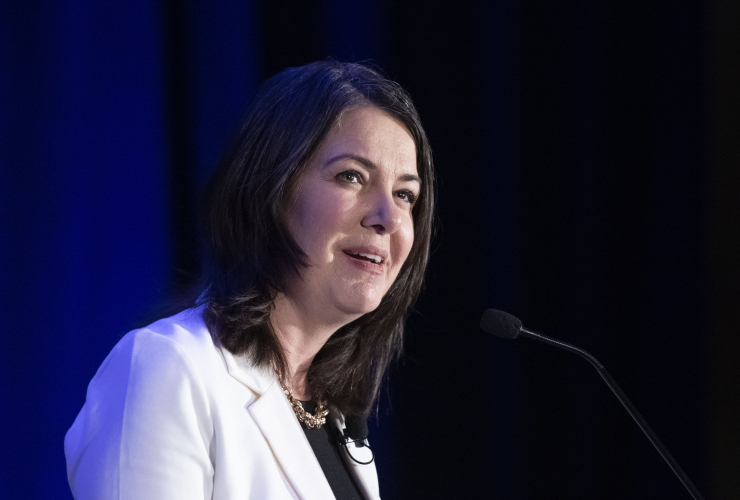The night before the Liberal government took the drastic step of invoking the Emergencies Act, the head of the RCMP sent a warning email to the office of the federal public security minister.
Commissioner Brenda Lucki wrote that police had not exhausted “all available tools” in dealing with protests that have gripped downtown Ottawa and several Canada-US border crossings.
But Public Safety Minister Marco Mendicino, who spearheaded the federal government’s response to the “Freedom Convoy” protest last winter, said in a public consultation Tuesday that Lucki never directly mentioned to him what he said in his email to your staff.
In a one-on-one call before a historic cabinet meeting on February 13, Mendicino said Lucki expressed “very serious concerns” about the blockade at the international border crossing in Coutts, Alta.
“She stressed to me that the situation in Coutts involved a hardened cell of people who were armed to the teeth, with deadly firearms who possessed the will to go down with the cause,” Mendicino testified before the Public Order Emergency Commission on Tuesday.
“This was a threshold moment for me.”
Based on their conversation, Mendicino said he “couldn’t have drawn any other inference” other than that Lucki supported invoking the Emergency Law.
What people are reading

The cabinet met later that night and Mendicino said he doesn’t believe the information in Lucki’s email ever surfaced. Prime Minister Justin Trudeau declared a federal emergency the next day.
The commission is investigating the facts that led to that decision and is tasked with determining whether the government was justified in invoking the Emergencies Law for the first time since it replaced the War Measures Law in 1988.
A formal investigation is mandatory whenever legislation is used to grant extraordinary powers to police, governments and banks, as happened during the Ottawa protests and border crossings.
Blockade of #Coutts in the mind of @marcomendicino on the eve of invoking the Emergency Law. #CDNPoli #EmergenciesAct #FreedomConvoy
The RCMP were able to arrest several protesters in Coutts and end the blockade without using the additional powers given to them by the Emergencies Act.
Even before hundreds of large trucks and thousands of protesters arrived at the parliamentary compound, Mendicino said he believed the protest had the potential to be violent, though the RCMP told him “most of the information” showed organizers were planning a peaceful event.
He said he felt videos like the one posted by controversial “Freedom Convoy” figure Pat King, referring to the protest that ended with bullets, were a “signal of intent”.
“There were many thousands of Canadians who participated in these demonstrations and the blockade who were there for totally legitimate and legal purposes, but some were prepared to turn violent,” Mendicino said.
Several federal cabinet ministers, including Dominic LeBlanc, had been concerned for their personal safety since the start of the protest in Ottawa because some protesters had posted online about attacking their homes, the inquest heard.
Notes from a ministerial briefing on January 26 show that the RCMP was aware of protesters trying to collect the addresses of members of Parliament, including Trudeau, and were concerned that the protest could splinter to include several locations near the politicians houses.
LeBlanc, the intergovernmental affairs minister, also testified Tuesday afternoon.
The RCMP tightened security around several cabinet ministers and Canada’s director of public health, Dr. Theresa Tam, because the protests focused on COVID-19 public health restrictions, Mendicino said.
As the protest in Ottawa unfolded, at provincial legislatures and at various border crossings, Mendicino said the situation was “bordering on being completely ungovernable.”
The commission has held weeks of peaceful hearings, but tensions erupted Tuesday after a tense exchange between the commissioner and the protest organizers’ lawyer, which ended with the lawyer being escorted out of the building.
Brendan Miller, who represents some protest organizers including Tamara Lich, interrupted Mendicino’s testimony on Tuesday to ask that the minister’s communications director, Alex Cohen, be called to testify.
Judge Paul Rouleau, the commissioner presiding over the investigation, asked security to remove Miller from the courtroom after the attorney spoke out about the commissioner and accused him of refusing to rule on similar requests.
“I’m trying to do my job,” Miller told reporters outside the Library and Archives building in Ottawa, where the hearings are being held.
Miller later apologized and was allowed to return to the hearing.
At the end of Mendicino’s testimony, Rouleau presented him with a hypothetical situation: “Let’s say there were two protests, one in Ottawa and one at the border in Windsor.”
He asked if it would be appropriate for provincial or federal politicians to tell their respective police services which protest was the priority for the government.
“I’ll give you a spoiler alert: Minister (Bill) Blair thought that would be inappropriate,” Rouleau said, suggesting the commission would investigate the relationship between politicians and their oversight bodies.
The commission has heard evidence for weeks about the murky line politicians are not supposed to cross when it comes to directing the police.
“The dilemma would be if both events were absolutely identical, would it be appropriate for the elected government to choose?” Mendicino said. “That’s not the kind of choice or dilemma you want.”
On the other hand, he said, if one was an emergency and the other was not, it might be appropriate to inform police that a protest had reached a higher threshold.
But he warned that politicians should not start instructing the police on the details.
“Elected governments should steer clear of that, and for good reason. I think there is a slippery slope that it would be very difficult to escape if we went down that path,” he said.
This report by The Canadian Press was first published on November 22, 2022.
